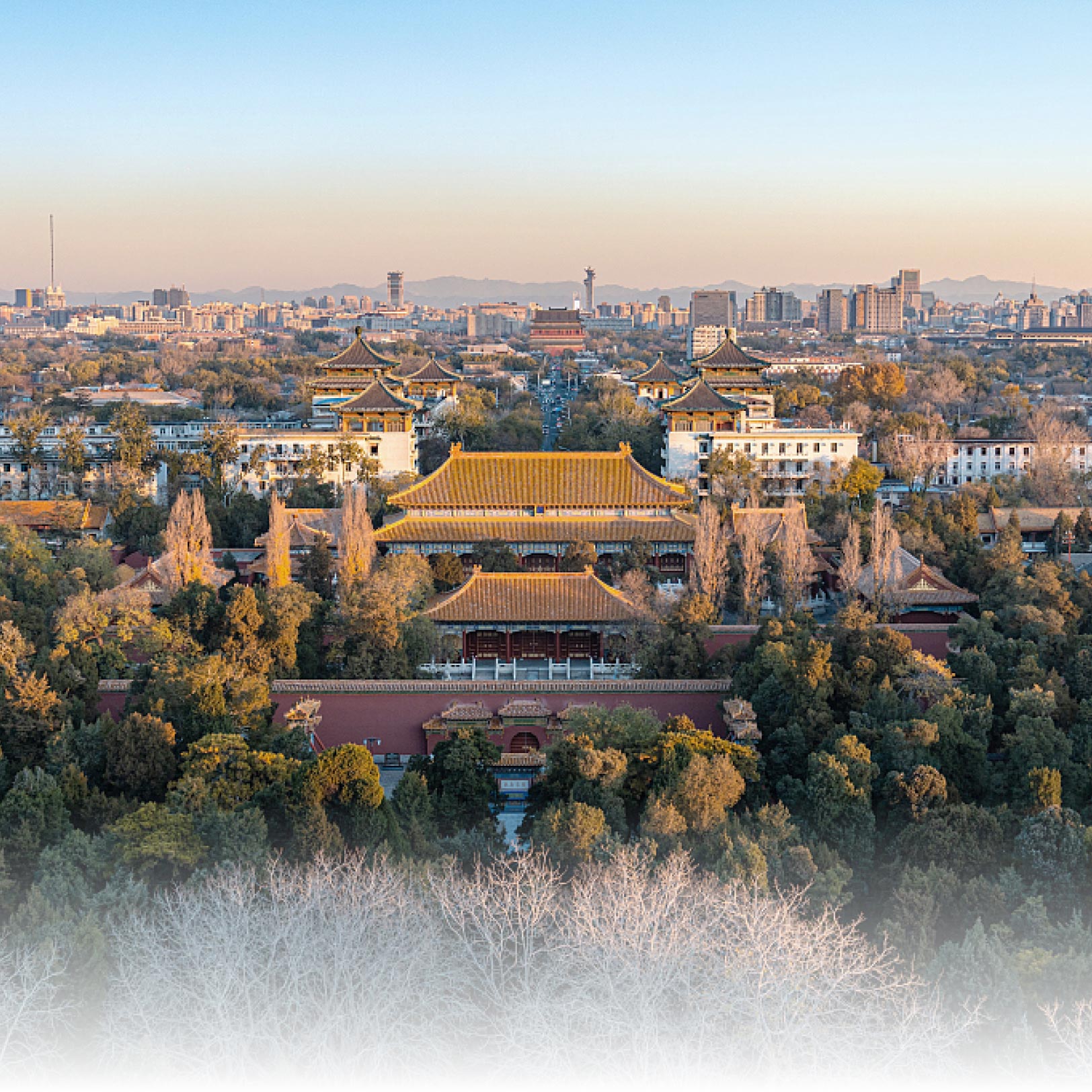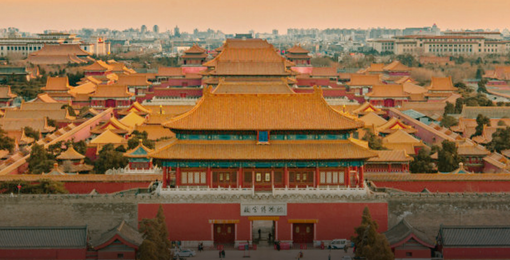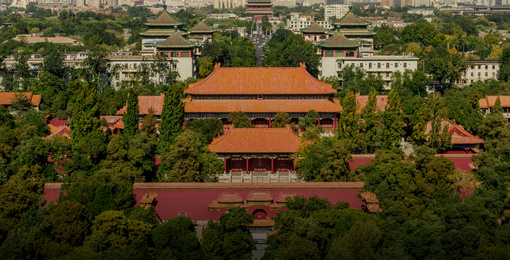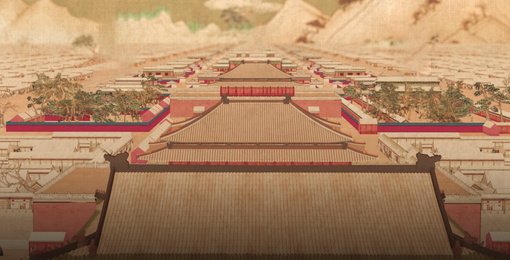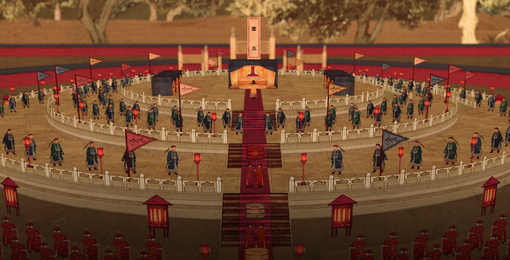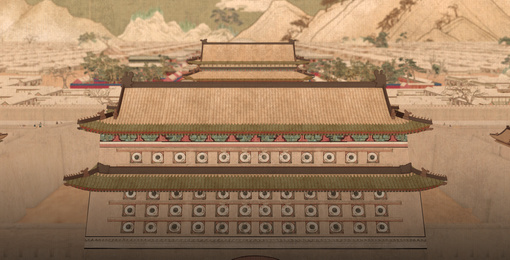







China has had a tradition of building royal gardens on the north side of the palace city. Cao Wei, one of the three states during the Three Kingdom period (220-280 CE), had the Fanglin Garden (Fragrant Grove Garden) built in the north of the palace city in Luoyang, the state’s capital (226-266 CE), beginning the tradition of the urban layout of having an imperial garden north of the palace city. After that, the Hualin Garden (Flower Grove Garden) of the Six Dynasties; the Hualin Garden (Flower Grove Garden) in Yecheng City, the capital of Eastern Wei and Northern Qi, the Taiye Lake in the Daming Palace in Chang’an City, the capital of the Tang dynasty; and Gen Yue (Impregnable Mountain) in Capital Dongjing of the Northern Song Dynasty were all laid out in the north or northeast of the palace city.

Continuing the function of the traditional Chinese royal garden and the etiquette system,the Forbidden City and the Jingshan Hill were important spaces for national ritual ceremonies,witnessing China’s diversified traditional ritual culture on Beijing Central Axis.
The Forbidden City was not only the residence of the emperors but also the venue for the highest level of rituals, such as the enthronement of the emperor and the starting point for ritual activities outside the imperial palace. Thus, the Axis forms a ritual space linked by central roads, consisting of the imperial palace, garden, and sacrificial buildings.
The gates on Beijing Central Axis from the south to the north in the order of the Gate of Supreme Harmony, the Meridian Gate, the Upright Gate, and the Tiananmen Gate were where specific ceremonies were held or where guards of honor must pass in the Ming and Qing dynasties. The architectural design of these city gates also highlights the connotation of etiquette. The high-grade buildings and their magnificent volumes reflect the significant difference from the other gates of Beijing’s Ming-Qing Old City outside the central axis. They constitute a tangible representation of the imperial ceremonial paths of the Ming and Qing dynasties, providing a powerful material witness to the etiquette culture of the Ming and Qing dynasties.

The Meridian Gate is the main entrance of the Forbidden City. Its design came from the traditional quemen (ceremonial gate tower). It was the late form of the evolution of the gate system in ancient China and also the most complete example of this architectural form. The Meridian Gate takes the “凹” shape in plan, forming a courtyard with rooms on both sides to evoke a strong sense of depth. It became the leading ceremonial sequencing space for the palace city’s rites and ceremonies. The oppressive and withdrawn spatial atmosphere is formed through the city gates and the high walls, sharply contrasting the Gate of Supreme Harmony Square to highlight the majesty of the monarch.
The location of the Forbidden City has remained unchanged since its completion during the Yongle reign of the Ming dynasty. Its layout of having the court in the front and dwellings in the back has remained intact. The space from the Gate of Supreme Harmony to the Gate of Heavenly Purity was where the emperor discussed and addressed state affairs with his courtiers. The Gate of Supreme Harmony marks the entrance of the Outer Court, where the emperor held daily court meetings and hosted banquets. The highlights of the Outer Court are the Three Main Halls. The Hall of Supreme Harmony was where the grand yearly gathering of officials took place, and essential ceremonies such as enthroning a new emperor were performed during the Ming and Qing dynasties. The Hall of Central Harmony was where the emperor received officials congratulating the ceremony and read their congratulatory articles before a grand ceremony began. The Ming dynasty emperors used the Hall of Preserving Harmony to change their clothes before a significant ceremony, and by the Qing dynasty scholars to take their final imperial examinations.

Sitting north of the Forbidden City, the Jingshan Hill had the dual functions of symbolizing the feng shui position and serving as a venue for sacrificial rituals. It not only continues the cultural connotation of ancient Chinese mountain worship but also shows the longstanding tradition of emperors’ enjoyment in royal gardens.
Since ancient times, China has had a tradition of worshipping mountains and rivers. The ancient Chinese regarded high platforms and mountains as venues to connect with the heaven and gods, thereby giving rise to worshiping such sacred mountains as the Kunlun Mountains, the Five Sacred Mountains, and the Five Garrison Mountains. Historical records show the tradition of building rockeries in royal gardens began in the Qin and Han dynasties and reached its peak in the Tang and Song dynasties. The Jingshan Hill followed this tradition. The hill was artificially heaped in the Ming dynasty on top of the palace ruins of the Yuan dynasty. Its tall peak commanded the view of the inner part of the imperial city. Today, it is still the commanding elevation on Beijing Central Axis, allowing an overlook of the Forbidden City in the south and the Bell and Drum Towers in the distant north.

Inheriting the historical tradition of having a royal garden in the imperial palace, the Jingshan Hill of the Ming and Qing dynasties boasts rich sightseeing functions. The royal families went on outings, ascended high to observe the Double Ninth Festival, kept a zoo, planted fruit trees, and practiced archery. Such a beautiful environment provided a lot of fun. According to historical records of the Ming dynasty, “The hill is covered with lush trees with many deer and cranes, their cries echoing each other and reaching into the sky. A staired earth path on the hill allowed His Majesty to climb to the top, where he could look as far into the distance as his eyes could reach.”
Besides the sightseeing function, the Jingshan Hill also played the role of accommodating various ritual activities. Emperor Qianlong of the Qing dynasty built the Hall of Imperial Longevity on Beijing Central Axis, making it more convenient for the emperor to offer sacrifices to the memorial portraits of his ancestors and emphasizing the tradition of filial duty. In 1751, five pavilions were added on the hill’s ridge, where statues of Buddha were enshrined, adding a third function of praying to the Buddha to the hill. In the same year, the Qiwang Belvedere was added to the building complex on the south of the hill, with a tablet of Confucius consecrated so that the imperial school students could worship the sage.







